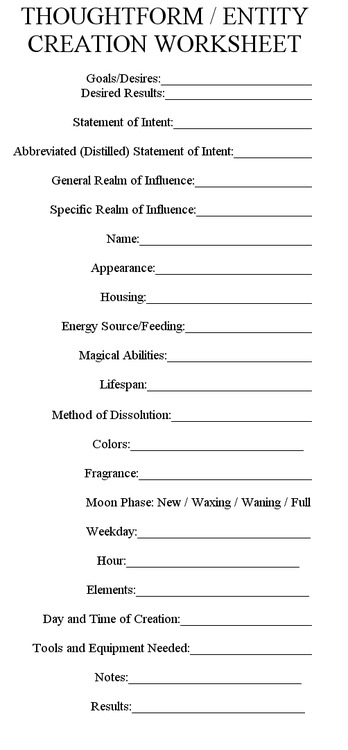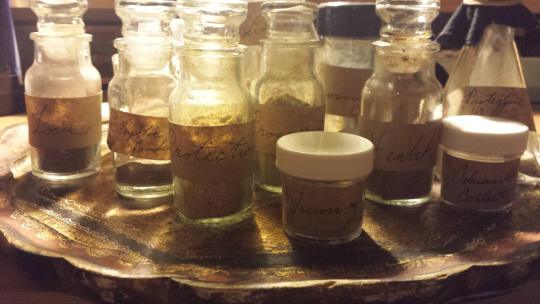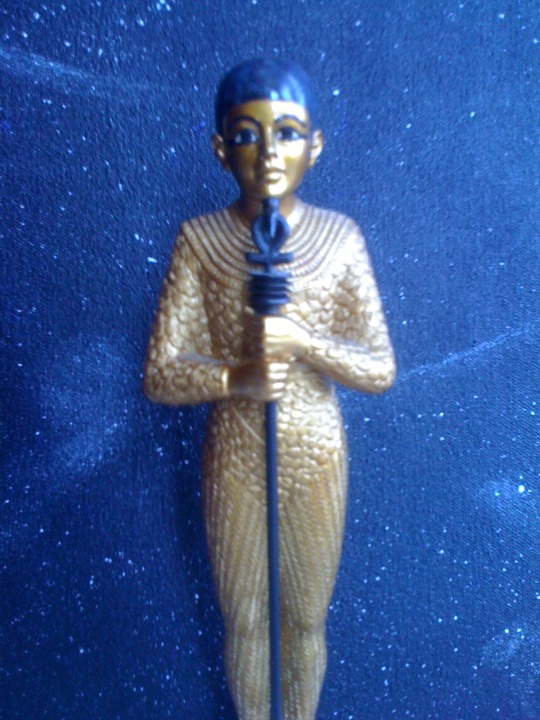Photo

BoS space-saver: fold-out series of things. Invocations with closings hidden under them, in this case. (The only downside is that, along with all the other taped-in pictures and pretty background stationery, the book will be harder to clasp closed than ever...)
8 notes
·
View notes
Text
All You Need for A Spell - is WINE
(I’m paraphrasing here from a book I loaned out years ago and never got back, but one lesson that stuck with me from Donald Michael Kraig’s Modern Magick, seems worth sharing with those who haven’t had the chance yet to read it.)
This may be particularly relevant for beginning witches, who are following spells straight from others’ books. In many cases, the specific ingredients may be difficult to find; the spell may or may not work. Not often succinctly outlined in these popular paperback grimoires, are the reasons a spell seems to require certain ingredients and actions, and if unsuccessful in practice, what you may have missed. While you might not yet be comfortable writing your own spells, going by the book may not be helpful if your mind and actions aren’t in tune with four aspects, best remembered by the acronym WINE:
Will
Intent
Necessity
and Energy
Whether a spell takes two hours or two minutes, the above are truly the only things you need.
Let’s look at each in relation to magic and spellcasting.
Will:
‘As I will it, so mote it be’, or any variation thereof, is a common phrase in (at least Wiccan) spellwork. But just saying the words won’t do much: you have to truly mean them. Whatever goal you’re working towards, you have to want the intended result very intensely. Meditation and divination beforehand are both excellent ways of focusing on your goal and thinking through its possible ripple effects. If there is any doubt in your mind or subconscious, if you are not wholeheartedly set on the intended result, then the spell is not likely to work.
Intent:
Your intent should be pure. For an example, say you had a breakup and want the person back, so you do a spell to re-open communications with them for the chance at fixing things. If you want to fix the relationship because you truly believe you belong together and it deserves a second chance, it might work. If you’re attempting to get them back just to hurt them for revenge, that is impure intent, and will muddy your efforts with negative energy, and terrible karma if it somehow works. Just as your Will should be 100% behind a magical working, so should your purity of intent. (This goes for dark magic, too, in a way: if your spell is of the negative sort, it should still focus on a certain aspect or action that you want to happen to the person, not an event that starts off a chain of future actions. Your spell should be reworked and simplified to focus on the immediate, if too many variables lead up to an eventual endgoal.)
Necessity:
Don’t be greedy with the resources and attention of the Universe: you should do magickal workings not just because you want something, but because you need it. A good example would be doing a spell to bring $100 your way. If you already have $1,000, you may not technically need that next hundred. However, if you have only $10…
Energy:
This is where the words to recite, herbs and candles to burn, dances to do, petitioning deities for additional help, etc. come into play. It’s not enough generally to think about what you want. If casting a spell, you’re compounding the above (will, intent, necessity) into a clear wish and sending it out into the world to be done. Well, a plane can’t take off without a runway. A fire can’t exist without the strike of a match. A spell is a send-off and so it should be bursting with energy. Spellbooks will often outline what the act should be, but if it’s counterintuitive to you, you should feel free to adjust the action to something stronger coming from yourself (so long as it’s appropriate to the main theme of the working.) You should have some sense of rising energy throughout the course of your casting, but there are countless ways to both build and send it out, and with practice you’ll find which suit you and the occasion.
I hope this helps!
31 notes
·
View notes
Text
Crash course on fake stones/misrepresentations
Because I have been too lazy to type this all up.
Quartz:
If your quartz has teeny air bubbles it’s glass.
If it’s got a fruit name it’s dyed. End of story. (strawberry, cherry, lemon, pineapple, blueberry) yes there may be some very rare exceptions-fire quartz being dubbed strawberry- but due to the rise in fakes with that name it’s generally called fire quartz now.
Aura quartz is a regular quartz that’s been bonded with another material. (man made)
Cinnabar Infused Quartz usually reconstituted and mixed together to make a red crystal.
Green quartz can be grown in a lab and anything that forrest green color is
Turquoise:
Magnesite and howlite look very very similar to turquoise when they’ve been dyed, magnesite will have very deep cracks in it though.
No there is no white turquoise.
You can do a uv test to see if it’s real
Amber
Often faked with Copal. They look nearly identical.
Amber will float in salt water-copal will not.
Irradiated/dyed stones:
Very vibrant colors!!
Irradiated: (they irradiate the crystals to get a deeper or more vibrant color)
deeply pigmented topaz or kunzite
dark (almost black) smokey quartz
very deep pink or red tourmaline
colored diamonds
some cultured pearls
vibrant yellow heliodor
Dyed:
Pearls
Agate
coral
other stones may be dyed as well, generally if it looks fake..it is.
Heat treated stones: (really not a bad thing but if you’re going for natural)
Amethyst-lighten color+remove brown
Citrine-heat treated amethyst.
Aquamarine-remove green
Ruby-clearer stone
Sapphire-clearer stone
Rainbow Cal-Silica
Nope, completely fake 100%
Literally just car paint layered with calcite and resin.
Citrine: (im so sorry)
Much of the citrine on the market is lab made.
If it’s lab made it’s usually amethyst that’s been heated until it changes color
The bottom of these stones will be white with more color at the tips.
srry
Lapis Lazuli:
High quality is vibrant blue, hard to come by, and very expensive.
Low quality howlite, jasper or sodalite is dyed blue, and passed off as lapis.
Acetone will remove the dye but damage the stone.
Obsidian:
The clear green obsidian you see all over ebay is slag glass.
Natural green obsidian has been found but it is opaque and is more gray than green.
there is red obsidian as well but again, it’s not a vibrant red and is more brick colored.
Wikipedia is not always right.
Goldstone:
it’s glass it’s legitimately just glass
Opalite:
also glass.
real opalite exists but it’s green and not commonly found
once again, don’t believe everything on wikipedia.
Bismuth:
Doesn’t naturally form in the crystals, lab made!!!
rlly pretty though
Hematite:
Not naturally magnetic!
Magnetic hematite is 100% man made!
I’ll add more as I come across them~
59K notes
·
View notes
Text
Yes, you can - or at least use them to add extra oomph to certain workings. They should, however, be musically and lyrically aligned to your intentions 100%. Ritualism and antiquated phrases that don't resonate with someone, won't be half as useful as words that genuinely touch someone and that they can relate to. Don't presume to limit the possibilities of someone else's experiences, please.
PSA FOR POP CULTURE PAGANS
DO NOT TURN PARAMORE SONGS INTO CURSES
AS A CHRISTIAN BAND THEY WOULD NOT APPRECIATE THIS AT ALL, NO MATTER THE REASON OR PURPOSE
IF YOU’RE GOING TO MAKE SPELLS BASED OFF OF PARAMORE SONGS MAKE THEM POSITIVE, HAPPY SPELLS THAT DO GOOD.
NO
CURSES
23K notes
·
View notes
Text
Hoping to be more active on this blog in the coming months.
Ask box is open.
0 notes
Text
A Short Guide to Thoughtforms
The understanding and use of thoughtforms was once reserved for magical practitioners – this is no longer the case. While the magically inclined may be more likely to suspend disbelief, there are many who interact with thoughtforms without true awareness of what they’re getting themselves into. As those in the know could tell you, this can have its unexpected downsides. Here, then, is an introductory guide to these unseen forces with whom we work, create and sympathize.
What are thoughtforms?
The term thoughtform has been in use as early as 1860, and borrows its definition from the Tibetan tulpa: “a concept in mysticism of a being or object which is created through sheer discipline alone. It is a materialized thought that has taken physical form.”
But that can’t really happen, can it? Can you really think something into existence?
Yes and No.
Let’s remember for a moment that nothing can exist, without first being thought of. How you think, and what you think about, can have a very big impact on your day. It’s accepted among practitioners that magic is in the mind, affecting the physical only when an amount of energy (effort, attention, belief, will, intent) is put behind a certain goal or hope. Instead of goals, thoughtforms are entities; embodiments of concepts, that act either as an addition to the initial spark that willed them into being (on some plane), or as channels of creative expression. Deities and protectors; magical constructs and beloved fictional characters. Will they fulfill the promise of the tulpa, and manifest physically? Unless you’re very good at visualization or embarking on a spiritual journey of which said manifestation is the main goal – no. But they are as real as any other thought you have, and considering the above, thoughts count for a lot.
As diverse as the people who dream them up, thoughtforms can be made and reached in many different ways. Any one person’s approach will vary from the next, for it’s up to the individual to recognize and assess their connections to thoughtforms. These can be embraced and understood by the mind that houses them, yet impossible to express in a way that would make sense to anyone else. Chances are if you’re still reading this, you have some experience with the basics of interaction - perhaps even unwittingly – and can sympathize with my hesitation to generalize what is always a personal experience. That being said, for the sake of simplicity, I would place common types into two groups: External, and Internal.
External Thoughtforms
Deities
Elementals
Internal Thoughtforms
Magical Purposes
Creative Expression
Borrowed Muses
~
How do they differ?
What are the benefits and drawbacks of interacting with them?
How do we connect to different types of thoughtforms?

I refer to deities, elementals and similar as external because they’re preexisting, and though their energies can be tapped into, the source of these energies is something far larger, stronger than a single person’s will. These are legends, ideas and gods that were imprinted long ago upon the imagination of mankind, and grow stronger with every single person who devotes any thought to them.
Deities
No disrespect is intended when referring to deities and godforms as thoughtforms. It seems too small and simple a term, especially when one actively worships them; how can one justify seeking answers from something they recognize as a mere thoughtform?
This is why symbols and signs are so important in magical practices, why so many questions revolve around how best to honor a specific deity. When you’re connecting with a god or goddess, you are connecting with the ideas, animals, sounds, scents, imagery and modes of thought related to it. The god is the face that represents a bundle of aspects whose energies you want to work with or praise. This spiritual connection can be nurtured but never forced, and any practitioner who honors their deities of choice would be hard pressed to name any downsides.
These forces have a strength that comes from the belief of many, and while we ‘look up’ to them and recognize their power, the act of channeling becomes easier when you reflect upon them as a thoughtform. Many magical traditions encourage channeling for holidays and rituals, with much consideration as to which member of the group could best represent the honored deity. Not just represent, but handle – depending on the deity, channeling them could make for a physically and mentally exhausting experience, and is best left to those who are most familiar and comfortable with them. Without the energy of an enthusiastic group setting, most attempts to embody a godform will fail. (This is probably a good thing.) Outside of ritual, a solitary practitioner can channel certain aspects and be a conduit of a godform’s energy; a call for protection or strength from a familiar goddess is one example in which the result is immediate. If a deity is known for protection, it is your mind that makes that relation and deems it important; it is the heart that seeks the reminder that you are protected, and transforms the reminder into belief in the deity, yourself, and the tie between the two.
Elementals
From culture to culture, elementals are known by countless different names and commonly accepted forms. Their energy source is the earth itself, and they can be found and touched in places where Nature still reigns. Earth, Air, Water, Fire and Aether have their own offspring, but these are children insofar only as they have their own names. Each embodies the whole, making grand energies more approachable to those who wish to understand them. They have traditions, likes, dislikes – most of these may have originated in fiction yet became the stereotype. If commonly accepted thinking can sustain a thoughtform’s existence, there’s little harm in starting with the stereotypes.
Belief in any specific ones, along with the urge to communicate, is encouraged by some magical traditions more than others, but it’s not as if Nature will be ignored. You don’t have to believe in gnomes to imagine they smell like rich earth, nor believe in sylphs to appreciate the touch of the wind. How and how much you relate is in your hands. Due to the wide variety of elementals, I will let this remain a tip-of-the-iceberg description, and encourage you to do your own research. (Jaq D. Hawkins’ Spirits of the Elements series is a good place to start for those new to elementals, and a comprehensive reference encyclopedia for those more familiar.)

Despite their ability to influence the physical world, I call these creations and characters internal, for their creator and energy source is you. But for in cases of borrowed muses, the goals, limits, and even the lifespan of these thoughtforms is your choice. Practitioners aware of the power of thought will often reserve thoughtforms for magical workings upon their chosen spiritual path. Non-practitioners have discovered them through creative pursuits and play.
(Thoughtforms For) Magical Purposes
These thoughtforms, also known as constructs, can take any shape and be created for any purpose. If you can think of it, you can think it into being. Allow that to sink in for a moment. Need to get a message to someone? Create a messenger. Want your home to be safe when you’re not there? Create a protector. A T-Rex may be impractical on the physical plane but on the astral, anything goes.
I may write a separate post on just the creation/destruction processes; in the meantime, here is the Thoughtform Creation Worksheet I once copied into my Book of Shadows. (Source unknown at the moment.)

These are the many things that should be considered before creating a thoughtform for a spell or other magical purpose. Why might it be important to limit its range of movement, or intelligence? Why decide its set goals beforehand, or how it will replenish its energy, or that it should die at all?
The Will, Intent, and Energy behind its creation, are what gives a thoughtform its astral life. The very act of creating it is energy, and the more detailed you are, the better.
Secondly, you are its creator and like a child, like karma, like the rule of three – it will come back to you.
While it may be sent away to accomplish goals, it came from you and so is connected to you. This applies to everything from the pleasure of having had a successful working, to any damage it may do with or without your instruction. A limited lifespan is recommended because your thoughtform may have worn out its original purpose, but gotten stronger over time, and find purposes of its own – what then?
- This has so far been written with magical practitioners in mind, and so to a casual reader, the line between astral and physical planes may already seem blurry. Here’s where it gets blurrier. -
Creative Expression
The above worksheet doesn’t differ much from the things writers consider when making a new character. Novelists have spoken of that moment when the character begins to express itself and guide the story in unanticipated directions. Something similar can happen to actors when developing a character, or if they’ve played the same character for a very long time - it could be argued that in some sense, Robert Downey, Jr. believes in Tony Stark, insofar as he gains confidence from the association - or an alternate personality is put forth to the public (one example being David Bowie and Ziggy Stardust.) The thoughtform itself can act as a protective wall.
Writers create many characters, just as actors play many parts, and so the perspective is one of the art, not of just the character. Because the writer is the creator, they maintain the control. The writer may have various songs, foods, habits, even clothing they use to channel a character, but this is treated almost as a ritual, something that has a clear end to the experience (excluding the odd bit of inspiration that comes from nowhere, or seems to come from the character itself).
It is work, vs. play. The thoughtform has gathered strength through being given attention, but as it was created in and for the art, is most likely to be content with its provided mode of expression and not become too disruptive elsewhere.
Also, because the characters are created for art, the end result can be interpreted in countless ways; as external interest in a character grows, it becomes a communal thoughtform, and no longer the responsibility of the creator alone.
Borrowed Muses
Let me start by saying, there is nothing wrong with RP, fanfiction or cosplay. These are all great ways to analyze art, see through the eyes of others, practice writing, learn new things through research, and have fun. However, this is the only ‘internal’ thoughtform type that does not come from yourself – you are acting as a conduit, and so this character passes through you, and can influence you in various ways. Your time and attention – both given freely – equal your thoughts. This is why the overall character of a thoughtform should be considered. You are inviting something with its own nature and thoughts into your very mind.
On the less-involved side of this expressive empathy, there is a set duration for the character’s presence: during a convention, or while writing. One is inspired by these characters and channels them somewhat, but the connection is fueled by certain costumes or plot ideas, intended to be temporary. Thoughtforms who grow into personal Muses are another story.
Out of admiration or similarities with oneself, these thoughtforms are welcomed time and again, given attention, even channeled when required for reasons in the physical world. Related interests, changes in wardrobe, adopted mannerisms; longings not your own, feeling as if your thoughtform goes where you do, an inability to reign them in or maintain control over how your time is spent – these are all signs that a thoughtform’s influence is spilling over into the physical realm, through you. Your mind, your body.
Is that necessarily a bad thing? If you’ve the free time to kill and think the mental journey a worthy one, then, no – so long as you can recognize and analyze the transition, and the ways it might genuinely change you. As in the pagan rituals mentioned earlier, the community might celebrate one for being so loyal and connected to a thoughtform – unlike the rituals, however, this admiration can continue even if it is clear that the connection has overtaken the personality of the conduit.
Some seek this and enjoy it. Some people can have a muse for weeks (often before a more interesting one distracts from it), some for years (sometimes called Soulbonds). Some conduits are stronger than others when it comes to shaking them off for days or months at a time, only to reinvite them or be (pleasantly?) surprised when the thoughtform makes itself known after an obvious absence. The depth and limits of this type of exploration will be different for everyone. Just as it may be difficult to understand unless you’ve experienced it, you may also not know where the line lies until you’ve crossed it.
Here are some things that you may want to consider before or as you feel a muse becoming closer.

Analyze constantly.
Know what you stand to gain from the experience.
Know what you stand to lose from the time and energy spent on the experience.
If these add up in your favor, carry on, and continue to be amazed at the little ways in which these muses will make themselves known.
If these do not add up in your favor, you may truly need to separate yourself from the muse in question. Depending on its strength or any other number of personal factors, this can be much harder than it sounds, and makes careful consideration from the start all the more important.
~
* Recommended Reading: The Magical Uses of Thoughtforms, Dolores Ashcroft Nowicki and J.H. Brennan
* My categorization system is my own; you may adopt it but know while doing research that these aren’t all common terms.
* Questions are always welcome.
339 notes
·
View notes
Note
((Hi um I've just gotten to this not too long ago, and I'm a noob so I was wondering if you had any advice...?))
This is kind of broad, and so my advice will be a little vague, but:
read everything and learn everything you can.
observe people and Nature as closely and often as possible.
always be on the lookout for signs from the Universe.
2 notes
·
View notes
Text
Hey, followers!
Please feel free to send Asks, even Anonymous. I'm most inspired to write, when given the topics. :)
3 notes
·
View notes


















